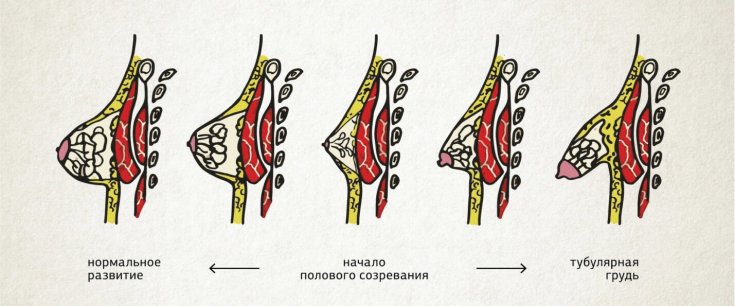The term "tubular breast" comes from the Latin word "tuba", which means tube.
Also, such an anomaly in the development of the mammary glands is called "goat breast" .
The elongated shape of the breast has a narrow base, the areola of the nipple protrudes outward, which looks like a cylinder or tube.
The incidence of tubular breasts is difficult to calculate because women may not see a doctor due to the lack of symptoms.
It is estimated that out of a thousand women, about 20 will probably have tubular breasts.
In women of the Negroid race, this anomaly of the mammary glands is more common.
Read more on estet-portal.com causes, manifestations, and modern methods of correction tubular breast.
- Causes and theories of tubular breast development in women
- What is formed incorrectly in the mammary gland with an anomaly
- What symptoms and sensations can tubular breasts cause
- Methods for correcting tubular breasts in womenn
Causes and theories for the development of tubular breasts in women
The very first signs of tubular breasts begin to appear in adolescence, which is associated with the growth of the breast itself under the influence of female hormones.
There are 3 theories for tubular breasts:
1. Teratogenic factors – referring to this hypothesis, this anomaly of breast development is congenital in nature and its cause is exposure to biological or chemical agents during prenatal development.
2. Genetic Factors – in the history of medicine, several familial cases of tubular breasts in women, their mothers and daughters are described.
However, the key genes and inheritance patterns have not been elucidated.
3. Acquired Factors – since there were no signs of malformations in the breasts of women with an anomaly before the onset of adolescence, some researchers do not agree with the congenital nature of the anomaly.
They cite problems with blood supply to the tissues of the mammary glands due to wearing wrong bras or due to other diseases.
To this day, the pathogenesis of the development of tubular breasts, as well as the exact causes of the anomaly, are being studied in order to obtain the opportunity to predict the development of tubular breasts and to carry out etiotropic treatment in advance and take preventive measureski.
The structure of the breast: a beautiful and vulnerable female organ
What is formed incorrectly in the mammary gland in case of anomaly
As the breast grows, the girl forms a dense frame, which consists of connective tissue, and does not allow fatty and glandular structures to grow in width.
Some parts of the connective stroma lose their elasticity and thicken, then a dense ring is formed at the base of the gland. The glandular components grow only within the case, so outwardly it looks like a lack of breast tissue.
In severe cases, the development of a tubular breast may be accompanied by compression of the gland tissues, deterioration of blood supply, against which the processes of sclerosis intensify.
Then in women, the areola area expands and is called "areolar hernia".

The process of forming a tubular breast is completed by the age of 20.
Afterward, the anomaly almost does not progress, and only during pregnancy and breastfeeding does the severity of the anomaly change.
Difficulties in the process of feeding of the child against the background of malnutrition of the jelly tissuess.
Read our content on Facebook!
What symptoms and sensations can tubular breasts cause
The presence of a tubular breast is detected during the initial external examination.
The gland is conical or cylindrical.
The base of the glands is narrowed, so there is an increase in the interthoracic space, as well as ptosis of the mammary glands.
The areolas are wide and often not appropriate for the woman's age.
Nipple may be flat or inverted.
No sensations and symptoms accompany the presence of tubular breastssya.
During lactation, there may be a lack of milk against the background of a decrease in the amount of glandular tissue, and also due to a violation of the structure of the nipple-areolar complex, the child may not grasp the breast correctly, which further reduces the amount of milk in a nursing woman.
"Tight breasts": an anatomical feature or a dangerous syndrome
Methods for correcting tubular breasts in women
There are no organic complications in women with tubular breasts.
The patients may experience aesthetic discomfort, up to the development of neurosis.
The diagnosis is not difficult and does not require additional diagnostic methods.
Mammologist conducts differential diagnostics with some types of
, the presence of inverted nipples, or an areolar hernia is a valid reason for mammography and breast ultrasound iron. In order to eliminate the pathology,
surgical correctionis performed, but only after the full formation of the mammary glands, that is, not earlier than 24 years.
Basic methods for correcting tubular breasts:
- Installing a fabric expander.
- This technique is used as a preparation for endoprosthetics.
At the same time,
the gland tissueis stretched to form a bed for the implant. After inserting the expander, its
cavity is filled with isotonic saline,increasing its volume every 2 weeks. The stretching lasts for at least 2 months, depending on the severity of the breast tissue deficiency.
- Breast arthroplasty.
- It uses a special technique for implant placement using periareolar access.
Sometimes it is necessary to select special implants to achieve the symmetry of the mammary glands.
- This type of surgical intervention can be performed as the final stage of correction for severe anomalies, or as an independent operation. In this case, the edges of the areola are excised, leaving about 4 cm of its diameter, and sutured to the skin.
Thus, for health and life
tubular breastsin women
does not threaten anything. However, psychological problems may develop from an unaesthetic appearance of the breast.
In this case, you can contact plastic surgeon-mammologist.
Female breasts after childbirth: how milk is produced







Add a comment